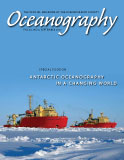First Paragraph
“Antarctic Oceanography in a Changing World” commemorates the twentieth anniversary of the commissioning of Research Vessel Icebreaker (RVIB) Nathaniel B. Palmer and the fifteenth anniversary of Antarctic Research and Supply Vessel (ARSV) Laurence M. Gould. The addition of these two Antarctic research vessels to the US fleet in the 1990s ushered in a new era of Antarctic oceanographic research for US scientists and their international collaborators. Although several US Coast Guard icebreakers in the Arctic and Antarctic waters conduct oceanographic research, their primary mission is icebreaking to facilitate access to land-based stations. The Palmer was, and remains to this day, the first and only purpose-built US research icebreaker in Antarctic service and has been serving sea-going scientists in all areas of Antarctica’s seas for two decades. The Gould has afforded reliable year-round access to Palmer Station and has conducted oceanographic research in the Antarctic Peninsula area since 1997.

